 |
Home | Charity | Feedback |
India: West Bengal:
Darjeeling,
Gangasagar,
Kolkata
Darjeeling, West Bengal, India: Queen of the hills by Prakash Bang, Editor in Chief 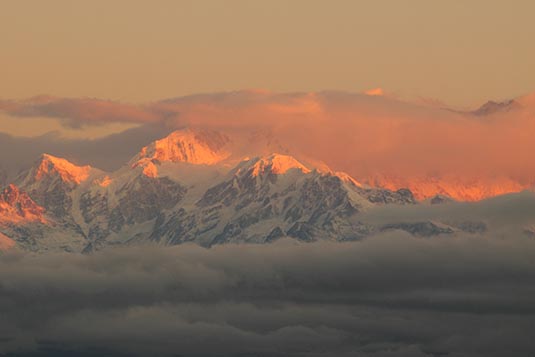 This pretty little town was a favourite during the English Raj. The legacy continues. Excellent climate all year round, majestic Himalayan Range overlooking the beautiful tea estates and friendly people all add up to justify the designation of this hill station. 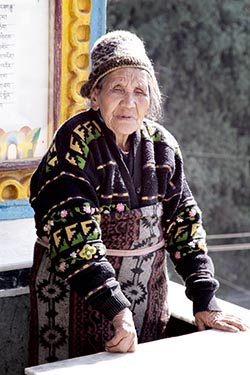 I was on a tour of a small part of Eastern India. I had kept aside 3 days for exploring the wonders of Darjeeling. Given the hilly terrain, the driving times and the attractions around, 3 days do not suffice. But then, that’s life. I need to move on.
I was on a tour of a small part of Eastern India. I had kept aside 3 days for exploring the wonders of Darjeeling. Given the hilly terrain, the driving times and the attractions around, 3 days do not suffice. But then, that’s life. I need to move on.
We were 2 couples travelling together. After spending 3 days in Gangtok, Sikkim, we drove to Darjeeling. For our stay here, we were booked at Hotel Mayfair. This is indeed a heritage property that has been restored into a fine hill resort. Though I did not get an opportunity to inspect other hotels, I am sure Mayfair would stand out as being amongst the best in Darjeeling. The hotel is quite a favourite with celebrities. During my stay, few stars from Bollywood were there to take part in the Darjeeling Tea & Tourism Festival. The food the hotel offered and the service their folks rendered was excellent. I was actually delighted by the efficiency of their room service. It all comes at a price of course. Mayfair offers 3 day packages that include breakfast, dinner and airport transfers. The nearest airport is Bagdogra which is only 90 kms away. But the travel time will not be less than 3 hours. Driving along the narrow-gauge railway line is pretty exciting. For our transfer from Gangtok, to Mayfair in Darjeeling, we paid Rs 1500. Since we were 4 travelling together hiring a cab for our exclusive use made sense. In any case, the public transport leaves much to be desired. 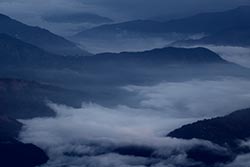 We left Gangtok at about 9AM. By the time we reached the hotel in Darjeeling it was 2PM. Enroute we made a few stops to refresh and take pictures. Of special mention is a high point that gives a panoramic view of the confluence of River Teesta and River Rangeet.
We left Gangtok at about 9AM. By the time we reached the hotel in Darjeeling it was 2PM. Enroute we made a few stops to refresh and take pictures. Of special mention is a high point that gives a panoramic view of the confluence of River Teesta and River Rangeet.
By the time we finished our lunch and settled in our rooms it was already 4PM and being winter months it was already getting dark. And fog had set in bringing with it crisp mountain chill. Rooms at Mayfair have a coal fired fireplace. The naked fire, heat blowers and hot-water bottles made a cozy package. We utilized the trio to the fullest extent possible during the days that we were there. 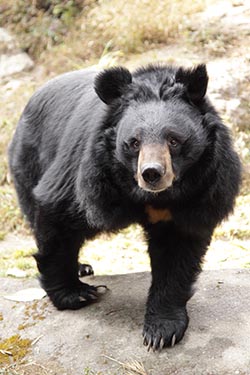 Since sightseeing in the evening was not possible, the next best was to spend time in the hotel campus itself. The hotel has a room named after Tenzing Norgay, the first person to climb Mount Everest. Norgay was from Darjeeling. This wood paneled room has English ambience. Walls are covered with pictures of various Everest expeditions and scores of relevant books add to the charm. One can easily spend hours in this room. From the cozy comforts we moved to the bonfire in the open. Soon it was dinner time.
Since sightseeing in the evening was not possible, the next best was to spend time in the hotel campus itself. The hotel has a room named after Tenzing Norgay, the first person to climb Mount Everest. Norgay was from Darjeeling. This wood paneled room has English ambience. Walls are covered with pictures of various Everest expeditions and scores of relevant books add to the charm. One can easily spend hours in this room. From the cozy comforts we moved to the bonfire in the open. Soon it was dinner time.
When in Darjeeling one most recommended trip is a visit to Tiger Hill that’s about 8 kms away from town. The location is ideal to see the sunrise that casts a magic over the Kanchenjunga mountain peaks. There’s a catch though. You have to start at about 4 in the morning. I am told hordes of other visitors would be there too. You need to be lucky to get a good viewing place, especially if one is keen in taking pictures. A covered observation deck is available for a small fee. But this will not be good enough for avid photographers as the glass panels will cause a disturbance. My fellow travelers were not quite in favour of negotiating the morning chill. Well, I was. 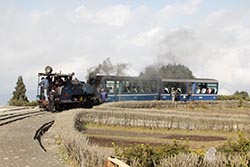 Let me give you a little tip. Just 100 meters away from the hotel, is Kanchenjunga view point. Surprisingly, this point is not very popular with tourists. However, locals come here for their morning exercises. I decided to give this point a try. And I was not at all disappointed.
Let me give you a little tip. Just 100 meters away from the hotel, is Kanchenjunga view point. Surprisingly, this point is not very popular with tourists. However, locals come here for their morning exercises. I decided to give this point a try. And I was not at all disappointed.
I woke up at 5AM the next morning. After appropriately protecting myself I set out with my tripod and camera. Thankfully, there were no clouds. At about 6AM the first rays of sun hit the mountain range. And for the next 30 minutes or so the drama kept happening. Had I been a poet, I could have written an award winning verse. Well, I let my camera do the writing. Honestly, I see no reason why one should go to Tiger Hills. Learned guides tell me that it’s a different experience but I would beg to differ. Of course, not going to Tiger Hills leave the taxi owners a bit deprived. 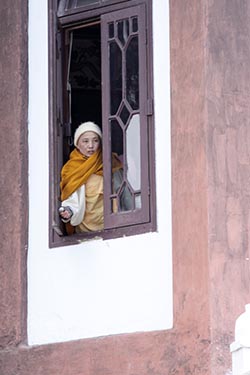 I was back in the room by 7:30AM. We had booked a taxi from our hotel’s travel desk. There are fixed sightseeing tours. We opted for a half-day tour costing Rs 850. The taxi would be ready for us at 10AM.
I was back in the room by 7:30AM. We had booked a taxi from our hotel’s travel desk. There are fixed sightseeing tours. We opted for a half-day tour costing Rs 850. The taxi would be ready for us at 10AM.
Our first stop for the morning was Peace Pagoda and Japanese Temple. As a symbol for World Peace, the building of the Peace Pagoda was initiated by Fuji Guru, the founder of the Nipponzan Myhoji Buddhist Order and a close friend of Mahatma Gandhi. The sparkling white pagoda rises 28.5 metres from the ground level and has a diameter of 23 metres. Embedded in the wall of the pagoda are four statues of Buddha in gold polish and eight carvings on sandstone depicting different stages of Gautam Buddha’s life. The Japanese temple is located near the peace pagoda and is designed in traditional Japanese style. From the Peace Pagoda we drove to Ava Art Gallery. The art gallery was established in 1965 by the couple Bhopal Rao Sett and Ava Devi. The gallery has a collection of works of art that includes paintings in water and in oil. The highlight indeed is the exquisite use of thread to make embroidered pictures. So delicate is the work that these embroideries appear to be as paintings. There's an entry fee of just Rs 2. I certainly recommend you to visit this gallery. It's located in Ghoom town only a few kms away from Darjeeling. Photography is not allowed in the gallery. 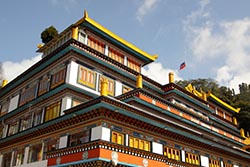 Our next stop was the Darjeeling zoo. Taxis will usually drop the passengers at the base of a hill. Visitors would need to foot the uphill road to reach the zoo. The premise also houses the famous Himalayan Mountaineering Institute. There’s an entrance ticket of Rs 40 per person. We hired a guide to show us around the zoo and more importantly to give us the nuances whilst visiting the HMI’s museum. Our guide was Bhushan and he did a wonderful job. His enthusiasm was inversely proportional to his small size. He cost us only Rs 100. The zoo is small but very well kept. I was delighted to see the Royal Bengal Tiger, the Black Himalayan Bear and the Red Panda.
Our next stop was the Darjeeling zoo. Taxis will usually drop the passengers at the base of a hill. Visitors would need to foot the uphill road to reach the zoo. The premise also houses the famous Himalayan Mountaineering Institute. There’s an entrance ticket of Rs 40 per person. We hired a guide to show us around the zoo and more importantly to give us the nuances whilst visiting the HMI’s museum. Our guide was Bhushan and he did a wonderful job. His enthusiasm was inversely proportional to his small size. He cost us only Rs 100. The zoo is small but very well kept. I was delighted to see the Royal Bengal Tiger, the Black Himalayan Bear and the Red Panda.
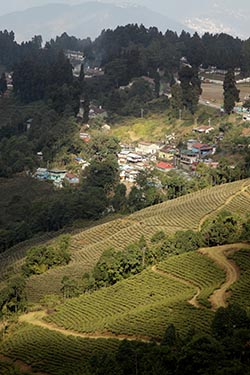 The HMI was started in 1954, as a result of the success of Tenzing Norgay’s ascent of Everest with Edmund Hilary in 1953. It has two museums – mountaineering and Everest - as well as a training department that runs courses in mountaineering. If you have a learned guide (as we had) a walk around the museum would be very interesting and rewarding.
The HMI was started in 1954, as a result of the success of Tenzing Norgay’s ascent of Everest with Edmund Hilary in 1953. It has two museums – mountaineering and Everest - as well as a training department that runs courses in mountaineering. If you have a learned guide (as we had) a walk around the museum would be very interesting and rewarding.
Darjeeling is world famous for its teas. And that would be our next stop – a visit to a tea estate. A few kms down hill, we parked along the road that gave us access to a few tea estates. Tea plucking was not in season but that didn’t take away the charm of seeing finely manicured tea plants basking in the winter sun and the Himalayan mist. Alongside the road, visitors can engage in some tea tasting and tea buying. A few kms uphill is the Tibetan Refugee Centre. The centre is located at Lebong at an altitude of about 7000 feet. It was established on 1 October 1959. The production of Tibetan handicraft is the centre's main activity. During my visit, the centre had minimal activity because the residents had left for an annual pilgrimage. 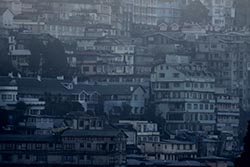 Our last stop for the day was The Mall. We chose to be left at the beginning of the Mall road. Our plan was to walk the Mall, have lunch and return to the hotel which was a good 10-minute walk.
Our last stop for the day was The Mall. We chose to be left at the beginning of the Mall road. Our plan was to walk the Mall, have lunch and return to the hotel which was a good 10-minute walk.
Mall road actually is a very narrow street with shops and kiosks on both sides. It’s here that one can buy local handicrafts, souvenirs, woollens and taste varied cuisine. At the time of my visit, the Mall was full to the brim with locals as well as tourists. If winter was an ‘off-season’, I wonder how the Mall would manage with its crowds in the summer months. 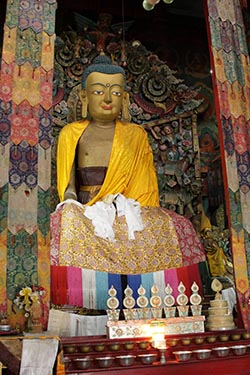 Since we had our wives with us we had anticipated a couple of hours on the street. We picked up a few souvenirs after indulging some serious bargaining. Like always, I was out of the scene… shopping has never been my forte. Lunch that afternoon was in restaurant located on the first floor. The windows opened up on the Mall road on one side and into the valley on another. The owners were Nepalese and so was the food that they offered.
Since we had our wives with us we had anticipated a couple of hours on the street. We picked up a few souvenirs after indulging some serious bargaining. Like always, I was out of the scene… shopping has never been my forte. Lunch that afternoon was in restaurant located on the first floor. The windows opened up on the Mall road on one side and into the valley on another. The owners were Nepalese and so was the food that they offered.
Nourished, we walked back to the hotel crossing the Chowraha (town’s famous square), Saint Andrews Church and the Gurkha Hall. Since Darjeeling’s Tea & Tourism Festival was on, we witnessed some local performances and visited few booths set-up at the Gorkha Hall. By the time we reached our hotel it was 5PM. Like yesterday, the rest of the evening was spent in the Tenzing Room and in sipping pre-dinner drinks around the bonfire. Early next morning, I set out to explore the sunrise. I was once again aptly rewarded for braving the chill. 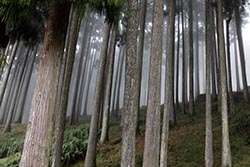 One of the main attractions in Darjeeling is to enjoy a ride on the Himalayan Train, lovingly named the Toy Train. Due to landslide, part of the train route was under repair. However, Indian Railways offer a joy ride on the train that lasts for 2 hours. There are 3 trips everyday that begin the journey from Darjeeling to Ghoom. The train turns back from Ghoom and makes a 10-minute stop mid-way at Batasia Loop giving the passengers time to enjoy the view and explore the War Memorial. Reservation to board the train is a must. The cost per round-trip is Rs 240. However, the train was fully booked and we lost the opportunity. I was not aware that tickets for this train can be purchased online 90 days in advance.
One of the main attractions in Darjeeling is to enjoy a ride on the Himalayan Train, lovingly named the Toy Train. Due to landslide, part of the train route was under repair. However, Indian Railways offer a joy ride on the train that lasts for 2 hours. There are 3 trips everyday that begin the journey from Darjeeling to Ghoom. The train turns back from Ghoom and makes a 10-minute stop mid-way at Batasia Loop giving the passengers time to enjoy the view and explore the War Memorial. Reservation to board the train is a must. The cost per round-trip is Rs 240. However, the train was fully booked and we lost the opportunity. I was not aware that tickets for this train can be purchased online 90 days in advance.
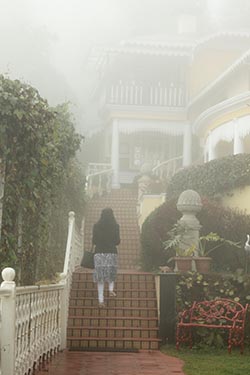 There was a way out, albeit a compromise. The next morning we hired a taxi that will take us to the Batasia Loop. The idea was to meet with the train out there! Batasia Loop is situated just outside Ghoom about 5 kms from Darjeeling. It was built to enable the train to descend the 1000 feet drop in altitude between Darjeeling and Ghoom. In the middle of the loop is a war memorial to Gorkha soldiers.
There was a way out, albeit a compromise. The next morning we hired a taxi that will take us to the Batasia Loop. The idea was to meet with the train out there! Batasia Loop is situated just outside Ghoom about 5 kms from Darjeeling. It was built to enable the train to descend the 1000 feet drop in altitude between Darjeeling and Ghoom. In the middle of the loop is a war memorial to Gorkha soldiers.
After the encounter and spending about an hour at Batasia Loop, we visited the Ghoom and the Dali Monasteries. Built in 1875 by Lama Sherab Gyatso, Ghum (Ghoom) Monastery is the popular name of the Sampten Choling Monastery or Yiga Choling Monastery located at Ghum at an elevation of 8,000 feet, 8 kms from Darjeeling. The monastery follows the Gelug school of Tibetan Buddhism. There is a 15-feet high statue of ‘Maitreya Buddha’ (Coming Buddha) in the monastery. It contains images of Buddha’s disciples, Chenrezi and Chongapa. 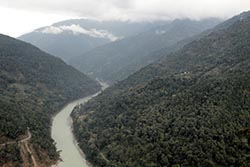 Dali Monastery is one of the most famous monasteries belonging to the Kargyupa sect. The pioneer of this monastery was Thuksay Rimpoche, who died in 1983 and his incarnate is reported to have been born in 1986 at Ladakh. This monastery is the headquarters of Drukchen Rimpoche XII, the supreme head of the Kargyupa lineage.
Dali Monastery is one of the most famous monasteries belonging to the Kargyupa sect. The pioneer of this monastery was Thuksay Rimpoche, who died in 1983 and his incarnate is reported to have been born in 1986 at Ladakh. This monastery is the headquarters of Drukchen Rimpoche XII, the supreme head of the Kargyupa lineage.
We returned to the hotel at about 1PM. Post lunch, we walked around a bit. Since nothing was more on the agenda (the fog and the chill prevented us from further exploration), we decided to call it a day. Relaxation was the order. The next morning, after breakfast we left for Bagdogra at 9:30AM. By 1PM we were at the airport. Airport drop was included in our package with Mayfair. My next destination was India’s most crowded metropolis – Kolkata, formerly Calcutta. Darjeeling Image Gallery  Photo viewer Photo viewer
|
|
|
Home |
Charity |
Feedback
Privacy Policy | Terms of Usage © YoGoYo.com. All rights reserved. |



































